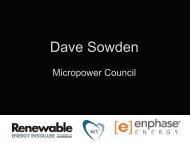REI Mar-Apr 2012 - Renewable Energy Installer
REI Mar-Apr 2012 - Renewable Energy Installer
REI Mar-Apr 2012 - Renewable Energy Installer
You also want an ePaper? Increase the reach of your titles
YUMPU automatically turns print PDFs into web optimized ePapers that Google loves.
Test case<br />
Knowledge: Solar PV<br />
Jim Wallace of Seaward Solar unravels the confusion surrounding solar PV<br />
testing and the use of appropriate test equipment<br />
he enormous expansion of the<br />
T<br />
solar PV market has presented<br />
significant opportunities for<br />
installers and suppliers of solar<br />
PV equipment.<br />
For the installer faced with the question<br />
of what test instruments to use, the matter is<br />
therefore one of being able to identify exactly<br />
what is needed to fulfil their obligations to the<br />
customer and also satisfy the various industry<br />
standards and best working practices.<br />
The requirement for all installers of<br />
PV systems in the UK is to satisfy the<br />
Microgeneration Installation Standard: MIS<br />
3002 which requires that PV systems are<br />
installed in accordance with the DTI’s “Guide<br />
to the installation of PV systems, 2nd Edition<br />
2006.”<br />
In addition to the guidance given by the<br />
DTI, a British Standard BS EN 62446:2009<br />
Pass the test: <strong>Installer</strong>s are faced with a range of<br />
issues when testing<br />
Grid connected PV systems – Minimum<br />
requirements for system documentation,<br />
commissioning tests and inspection has<br />
been published, giving details of specific<br />
electrical tests that should be performed all<br />
on PV systems at the time of installation and<br />
commissioning.<br />
Fundamentally, a PV system is part<br />
of the electrical installation and therefore<br />
the electrical works should comply with<br />
the requirements of BS 7671 IEE Wiring<br />
Regulations 17th Edition, along with the<br />
particular requirements for the inspection<br />
and testing of DC circuits specified by BS EN<br />
62446.<br />
Earth continuity<br />
Where protective earthing and/or<br />
equipotential bonding conductors are fitted<br />
on the DC side of the installation, for example<br />
bonding of the array frame, the continuity<br />
should be tested. The connection to the<br />
main earthing terminal should be tested.<br />
An instrument which complies with the<br />
requirements of BS EN 61557-2 should be<br />
used.<br />
Open circuit voltage and polarity<br />
Prior to installation, it is good practise to<br />
measure the open circuit voltage of each PV<br />
module and compare the measured value with<br />
that on the rating plate to ensure that each<br />
module is functioning. It is much easier to<br />
correct problems or replace a faulty module<br />
before it is installed. It should be remembered<br />
that the data shown on the rating plate is<br />
taken under standard test conditions and<br />
values measured in the field may deviate from<br />
those shown on the rating plate. The polarity<br />
of the DC cables should also be checked to<br />
ensure it is correct.<br />
When the modules have been installed,<br />
the open circuit voltage of each string should<br />
be measured and compared with the expected<br />
value. The polarity should also be confirmed.<br />
For systems with multiple identical strings,<br />
the open circuit string voltages should be<br />
compared. For stable irradiance conditions the<br />
values should typically be within 5 per cent.<br />
The measured open circuit voltage for each<br />
string should also be recorded on a PV array<br />
test report.<br />
Voltages less than the expected values<br />
may indicate that one or more modules are<br />
connected with incorrect polarity or insulation<br />
faults. Higher voltages are usually the result of<br />
wiring errors.<br />
Short circuit current<br />
The string short circuit current is measured by<br />
applying a temporary short circuit across the<br />
DC terminals of the PV string and measuring<br />
the resultant DC current. The apparatus used<br />
to apply the short circuit must have a rating<br />
greater than the potential short circuit current<br />
and open circuit voltage.<br />
The temporary short circuit can be<br />
applied by a short circuit cable connected<br />
into a switching device already present in<br />
the string circuit, a suitably rated test box or<br />
a dedicated PV short circuit test instrument.<br />
When the temporary short circuit has been<br />
applied, the short circuit current can be<br />
measured using a suitably rated DC current<br />
clamp or in-line DC ammeter. In the case of<br />
a dedicated PV test instrument, such as the<br />
Seaward Solar PV100, the short circuit load<br />
and in-line DC ammeter are housed within the<br />
test instrument.<br />
For systems with multiple identical<br />
strings, the short circuit string currents should<br />
be compared. For stable irradiance conditions<br />
the values should typically be within 5 per<br />
cent. The measured short circuit current for<br />
each string should be recorded on a PV array<br />
test report.<br />
It should be remembered that applying or<br />
removing a short circuit on a live PV system<br />
is potentially hazardous. Care should be taken<br />
to avoid risk of electric shock or damage<br />
due to electrical arcing. The installer should<br />
therefore give careful consideration as to how<br />
this test is to be performed and ideally use an<br />
instrument which is capable of automatically<br />
applying a short circuit and measuring<br />
accurately the current during the test.<br />
www.renewableenergyinstaller.co.uk | 65














